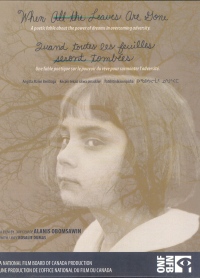| ________________
CM . . . . Volume XVIII Number 26 . . . . March 9, 2012
A haunting fiddle tune accompanies the opening scenes of When All the Leaves Are Gone; a road is surrounded by an old forest, waters rush over rocks, a garter snake slithers through the grass. Then, an older woman, holding hands with a young girl, walks into view. The young girl is Wato, and the woman, her old Aunt Helen. They live in a village called Audenac, a place where Wato feels much loved and secure. However, circumstances compel them to move to "the city", a place which has two pulp mills and "stinks all the time." It is 1940, Canada is at war, and life in this city is very different from the quiet village in which Wato and her family lived. In the city, bread comes from a bakery, not from her Aunt Jessie's bake oven, the streets are filled with horse-drawn delivery vehicles (Wato loves the horses), and, of course, there is the parish church, attended regularly by her devout mother ("more Catholic than the Pope") and to which Wato is also taken. Wato's father has tuberculosis in the bones, and so he is hospitalized and isolated from his family. His case is a serious one. In autumn, Wato's mother tells her to look at the tree which faces onto the back yard of their row-house. If her father is still alive "when all the leaves are gone", it is a sign that he will continue to live. Not a happy situation for the eight-year-old, and school is no better. She is the only Indian in the classroom, and by her admission, "a lot of the kids hate me." And when she picks up her text-book containing the History of Canada, she reads the history of her people, living in a pre-Confederation Canada which is "inhabited by two races of savages", cruel, warlike, ignorant, and pagan. One day, on her way home from school, she is chased by two of her school mates. Running to escape her tormentors, Wato falls, and the two girls slap her and insult her, calling her "a dirty savage". However, a kind woman from the neighbourhood intervenes and comforts her, after roundly scolding the two little bullies. As Wato walks to church, she recalls the words of her father who told her that "the cruelest torture is that our country was stolen, our languages were silenced." But she has hope in his belief that "some day, our people will have a voice again." At church, she stands before the statue of the kind-faced St. Joseph, her favourite saint. She implores him to recognize her: "It's me, Wato." And then, the inevitable: the leaves are all gone, and so, too, is her father. Up to this point, the film has been black and white, but now, it changes to the sombre colours of autumn. As the day slowly dawns, an older woman sits beside a small fire, and Wato kneels, face down, on a colourful blanket. In a dream sequence, two figures dressed as horses come to the sleeping child. She awakens from their gentle nuzzling, and they comfort her. "Papa, the sun is rising. I am dancing. Can you see me?" As suddenly as they appeared, the horse figures depart to the forest, accompanied by the haunting strains of the fiddle music which is the music of this film. Based upon the personal experiences of Alanis Obomsawin, When All the Leaves Are Gone powerfully depicts the feelings of exclusion, hurt, and loss suffered by the young Wato. Her voice-over commentary presents a child's perspectives on her situation, and the black and white film footage (a skilful blend of current and archival material from the NFB and CBC) provides vignettes of life in the Quebec of 1940. Wato's situation is a difficult one, and one which was experienced by countless numbers of First Nations children, whether in reserve, residential, or urban schools. Her childlike faith in St. Joseph goes unrewarded, while her father's words sustain and console her. And the horse-creatures who comfort her as she awakens seem to be an embodiment of that hope. A short film (just over 17 minutes of running time), When All the Leaves are Gone offers a glimpse into the situation of a First Nations child who not only finds herself in a strange new environment, but who also experiences racism from her peers and institutionalized disdain for her ancestors and their history. But, it could also be the story of any child who is transplanted from all that is secure and familiar to an environment that is unfriendly and, at times, downright hostile. Immigrants and refugees can also identify with this story, despite its being situated in the historical context of Canada during the early years of World War II. When All the Leaves are Gone can be used in Canadian history classes at the senior high school level, as well as in Native Studies programs. The film also contains French language audio, as well as audio content in two First Nations languages, Innu, and Inuktitut. Some students might wonder about the dream sequence at the end of the film, but it is certainly a lyrical ending to a story with some very harsh notes. Recommended. Joanne Peters, a retired teacher-librarian, lives in Winnipeg, MB.
To comment
on this title or this review, send mail to cm@umanitoba.ca.
Copyright © the Manitoba Library Association. Reproduction for personal
use is permitted only if this copyright notice is maintained. Any
other reproduction is prohibited without permission.
NEXT REVIEW |
TABLE OF CONTENTS FOR THIS ISSUE
- March 9, 2012.
AUTHORS |
TITLES |
MEDIA REVIEWS |
PROFILES |
BACK ISSUES |
SEARCH |
CMARCHIVE |
HOME |
